 Featured: Oscar de la Renta Tiered Gown
Featured: Oscar de la Renta Tiered Gown
Among the occasion gowns, a tiered empire-waisted number is always a standout with its elegant double-ruffled flounce. In coral silk taffeta, it’s unmistakably Oscar.
You will need:
- Approx. 4 ½ – 5 yds. [4.2 – 4.6 m] of fashion fabric, 60” [152 cm] wide
- 1 dress zipper, approx. 15” [30 cm] long
- Coordinating thread
- Kraft paper
MEASUREMENTS
Bust – measure around the fullest part of breast, just under the arm.
Chest – measure around upper torso, just under the breast.
Waist – measure around narrowest part of torso, just above navel.
Back width – measure across shoulder blades from armhole to armhole.
Back waist length – measure vertically from nape of neck to waistline.
Dart Size = 2 ¾” [7 cm]. (This is an average bust dart amount for a B-cup. More or less darting may be taken, if desired.)
PATTERN
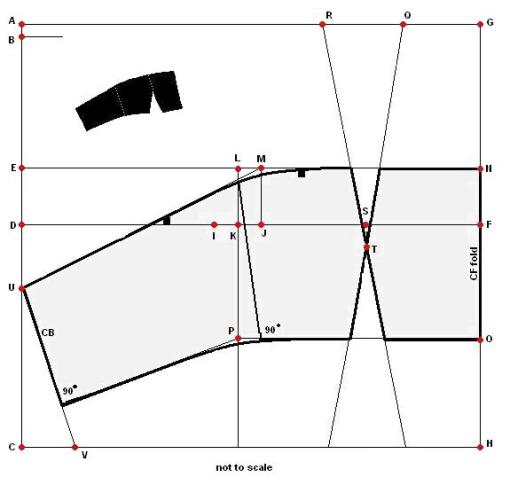
Bodice Section:
Draw 2 lines at a 90° angle from point A.
A-B = ¾” [20mm].
B-C = back waist length.
Square across from C. (waistline)
B-D = half of B-C. (bustline)
D-E = quarter of B-C.
D-F = half of bust measurement.
Square up and down from F to locate G and H.
D-I = half of back width
F-J = half of back width + half of dart + ½” [12 mm].
K is located midway between I and J.
Square up from K to located L.
M is located at the intersection from J.
N is located at the intersection on the centerfront line.
F-O = 2 times distance of N-F.
Square across from O.
Square down from K to locate P at intersection.
G-Q = 3” [75 mm].
Q-R = dart size.
F-S = half of line F-J.
S-T = ½’ [12 mm].
Connect Q to T with a straight line and extend to waistline.
Connect R to T with a straight line and extend to waistline.
D-U = quarter of C-D.
Connect M to U with a straight line.
H-V = half of waist measurement less darting.
Join U to V with a straight line.
Place set square on line U-V and draw a line at a 90° angle to connect to P.
At M and P, smooth the chevron with a curve to blend the lines together.
Place set square on baseline and square a line to L. (side seam)
Shoulder strap front placement is located midway between side seam and dart. (■)
Shoulder strap back placement from side seam equals front amount + 1” [25 mm].
To complete draft, cut through the center of the bottom dart and close top dart to release it into bottom dart, pivoting at T. (see silhouette in diagram above)
Fitting Tip: Measure the bottom edge of the bodice pattern and compare to the chest measurement. Adjust the dart with the difference, if necessary.
Grainlines are parallel to CF and CB.
Add ½” [12 mm] seam allowance to bodice pattern. (Cut front pattern on fold)
For shoulder strap, draw a rectangle = back waist length X 5” [12.5 cm].
Skirt Section:
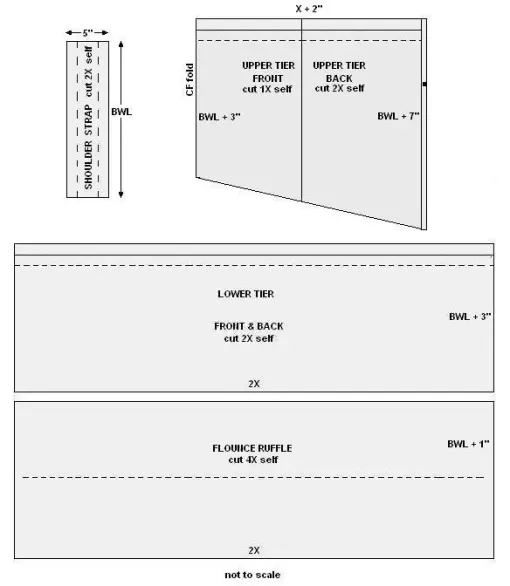
Measure bottom edge of bodice, less darts . This amount is X.
For the upper tier, draw a rectangle.
Make the CF = ½ X – 1” [25 mm] x back waist length + 3” [75 mm].
Make the CB = ½ X + 1” [25 mm] x back waist length + 7” [180 mm].
Connect the bottom with a diagonal line and divide the pattern.
For the lower tier (front & back), draw a rectangle = 2X x back waist length + 3” [75mm].
For the ruffled flounce, draw a rectangle = 2X x back waist length + 1” [25 mm].
Grainlines are parallel to CF and CB. (Cut upper tier front pattern on the fold).
Note: Seam allowance (1/2″ or 12 mm) is included in skirt section.
Fitting Tip: The finished length may be adapted by adding or subtracting equal amounts from the top edge of the tier panels. Take gown length measurement while wearing evening shoes.
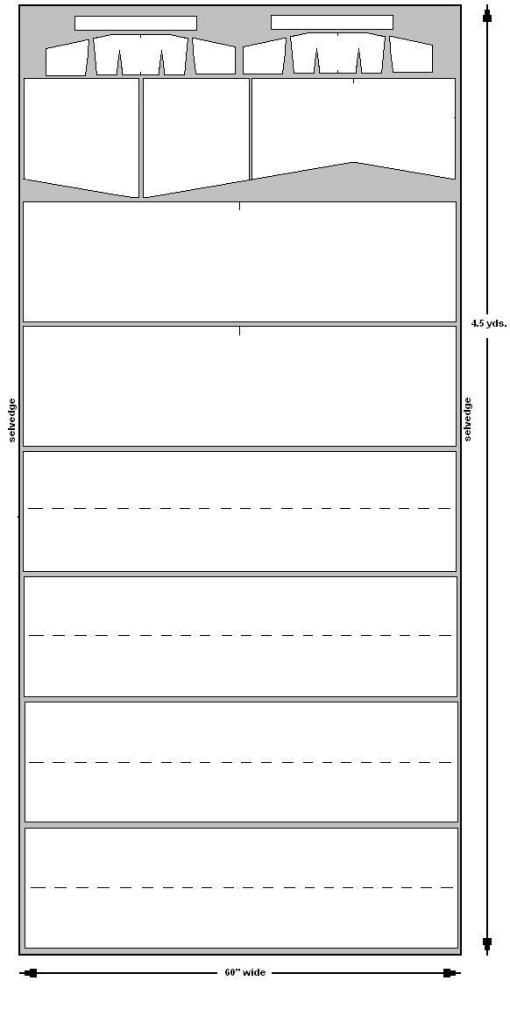
CUTTING
Shoulder Straps – cut 2X self
Bodice Front – cut 2X self
Bodice Back – cut 4X self
Upper Tier Front – cut 1X self
Upper Tier Back – cut 2X self
Lower Tier – cut 2X self
Flounce Ruffle – cut 4X self
ASSEMBLY
1. Make 2 shoulder straps. With right sides together (RST), fold strap piece in half lengthwise and sew along long open edge. Press seam open. Turn strap RIGHT SIDE OUT. Center seam in middle of width and press flat. Set aside.
2. Make flounce. With RST, sew ruffle panels together along short ends of rectangle to make a “loop”. Press seams open.
With RST, fold the loop in half aligning the raw edges and matching the seams. Sew around the loop, leaving a 6” [15 cm] opening for turning out. Turn flounce RIGHT SIDE OUT and fold 2” [50mm] from seam. Press gently along fold. Set aside.
3. Sew darts on front bodice pieces.
4. Sew bodice backs to bodice front at side seams. Press seams open.
5. Pin/baste shoulder straps to bodice at ■. (You may need to adjust its length).
6. With RST, sew the bodice pieces together along the top edge, ensuring to catch shoulder straps in the stitching. With inner bodice (lining) FACE UP, under-stitch along top edge of bodice. Turn under seam allowance on lower edge of inner bodice and press flat. Set aside.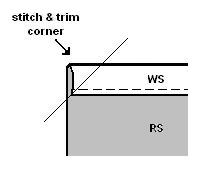
7. With RST, sew upper tier backs to upper tier front, matching at side seams and CB seam from bottom of zipper opening. Press seams open.
Turn under top edge of upper tier by 1 ½” [40 mm] and gently press fold.
With RST, stitch a diagonal seam at each corner of zipper opening. Trim excess away and turn RIGHT SIDE OUT. Set aside.
8. With RST, sew lower tier panels at side seams and press seams open. Turn under top edge of lower tier by 1 ½” [40 mm] and gently press fold. Hem bottom edge with a ¼” [6 mm] double-rolled hem finish.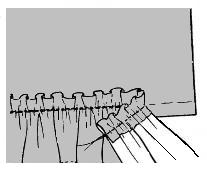
9. With lower tier and flounce FACE UP, attach flounce to bottom edge of lower tier. Gather along the horizontal seam of the flounce and ruffle the top edge. Distribute the gathers evenly along the bottom edge of the lower tier and stitch through all the layers 2” [50 mm] from fold. ( gathering ratio = 2:1)
10. With upper and lower tiers FACE UP, attach lower tier to bottom edge of upper tier matching at the side seams. Gather 1” [25 mm] from the top fold of the lower tier and ruffle the top edge. Distribute the gathers evenly along the bottom edge of the upper tier and stitch through all the layers 1” [25 mm] from fold. (ratio = 2:1). From inside the garment, stitch the ½” [12 mm] seam allowance of the lower tier to bottom edge of upper tier.
11. With upper tier and bodice FACE UP, attach upper tier to bottom edge of bodice matching at the CF, side seams, and CB seam. Gather 1” [25 mm] from the top fold of the upper tier and ruffle the top edge. Distribute the gathers evenly along the bottom edge of the bodice and stitch through all the layers 1” [25 mm] from fold. (gathering ratio = 2:1). Press seam upward.
12. Insert dress zipper into CB seam from top of bodice using the center slot application.
13. Align bottom edge of inner bodice to stitching line and match at seams. Slip-stitch along bottom edge of inner bodice and along zipper tape.
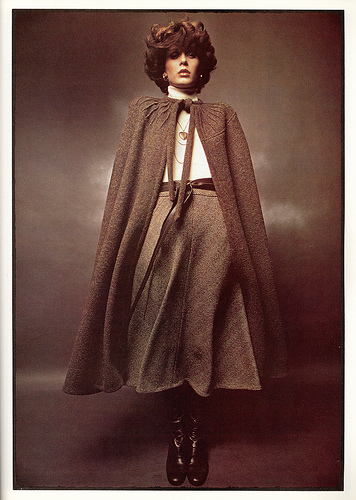 Featured: Luba tweed cloak
Featured: Luba tweed cloak
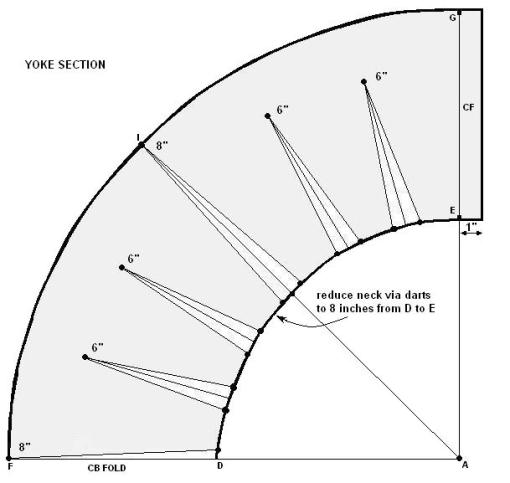
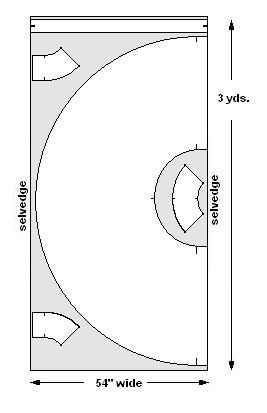 CUTTING
CUTTING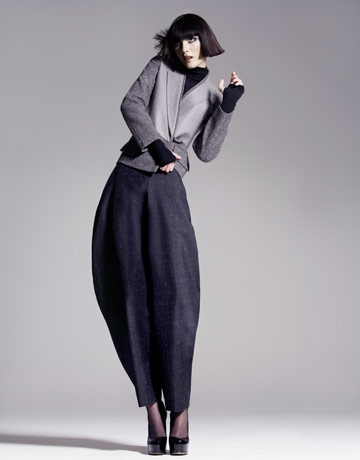 Featured: Stefano Pilati for YVES SAINT LAURENT
Featured: Stefano Pilati for YVES SAINT LAURENT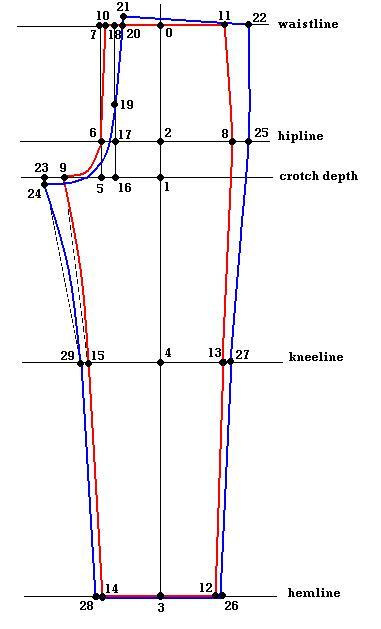

 Mirror the final dimensions of the waistband along the foldline.
Mirror the final dimensions of the waistband along the foldline.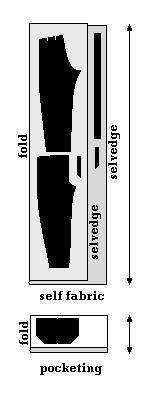 * Add seam allowances to all pattern pieces.
* Add seam allowances to all pattern pieces. With RST, sew curved edge of fly facing.
With RST, sew curved edge of fly facing.  Pull one leg RIGHT SIDE OUT and drop down into other leg. Align and match up inner leg seam and CB crotch seam. Baste/pin crotch seam. Sew seam from bottom of fly to top edge of back section (in a U-shape). Turn garment RIGHT SIDE OUT and set aside.
Pull one leg RIGHT SIDE OUT and drop down into other leg. Align and match up inner leg seam and CB crotch seam. Baste/pin crotch seam. Sew seam from bottom of fly to top edge of back section (in a U-shape). Turn garment RIGHT SIDE OUT and set aside. Featured: Ella Moss Camisole
Featured: Ella Moss Camisole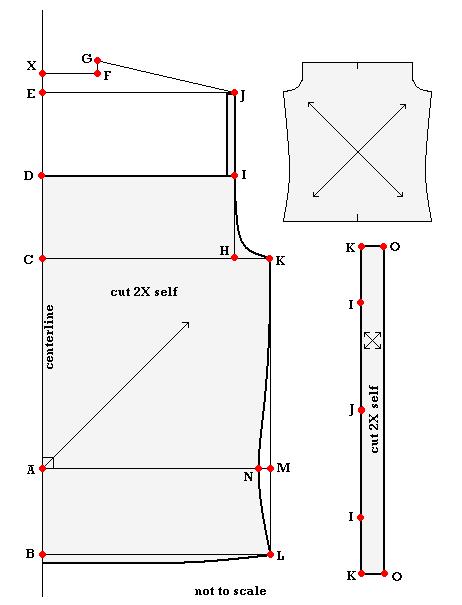
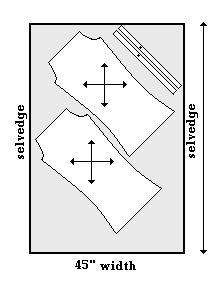 CUTTING
CUTTING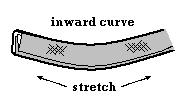 With right sides together, align and match front to back at side seams. Stitch 1” [25mm] from top edge on stitching line. Stay-stitch the armholes.
With right sides together, align and match front to back at side seams. Stitch 1” [25mm] from top edge on stitching line. Stay-stitch the armholes.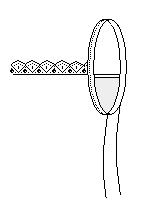 Pre-shape the bias binding to match armhole edge of garment by stretching the two folded edges to match the shape of the inward curve of the armhole.
Pre-shape the bias binding to match armhole edge of garment by stretching the two folded edges to match the shape of the inward curve of the armhole. Featured: Club Jacket by Sanmar
Featured: Club Jacket by Sanmar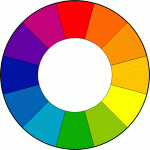
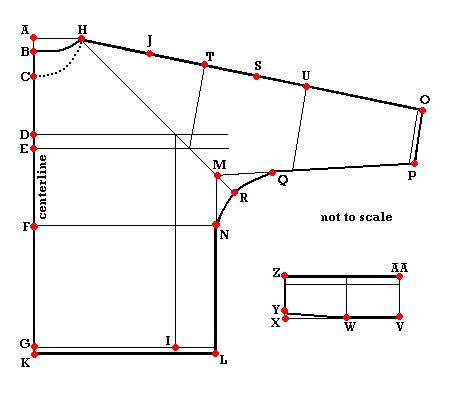
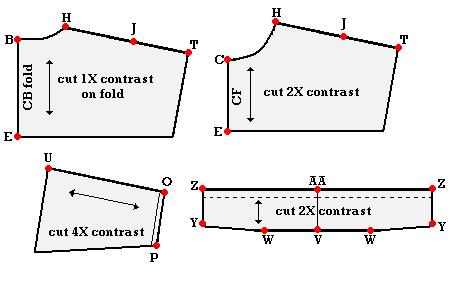
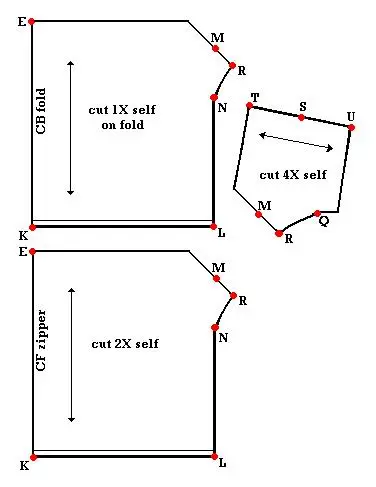
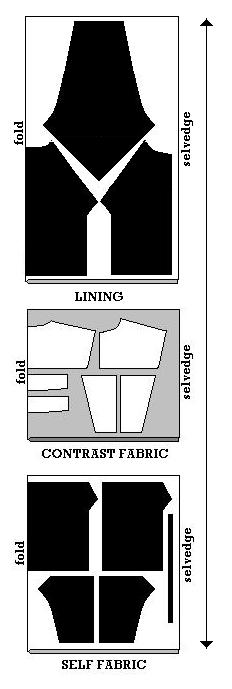

 Featured: Salvatore Ferragamo
Featured: Salvatore Ferragamo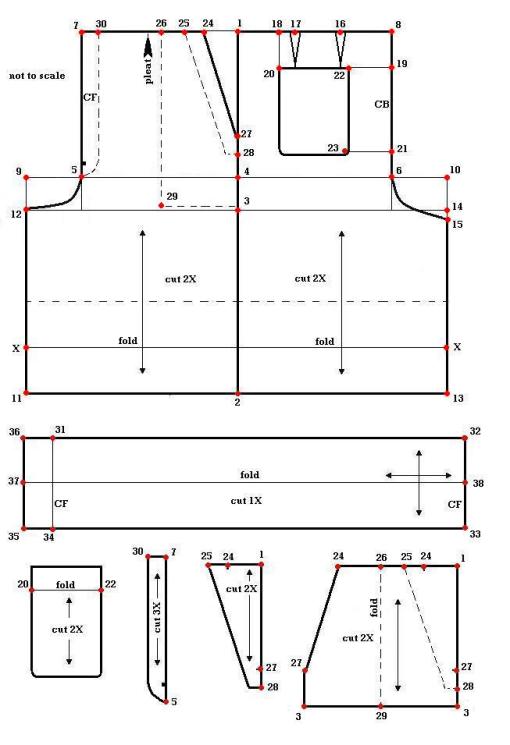
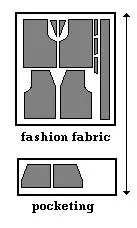 Front – cut 2X self
Front – cut 2X self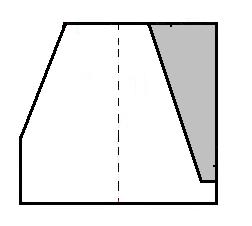 2. Finish seams on all cut pieces with
2. Finish seams on all cut pieces with  5. Stitch a
5. Stitch a  7. With RST, sew fly to right front leg. Grade seam allowance and press seam to one side.
7. With RST, sew fly to right front leg. Grade seam allowance and press seam to one side. 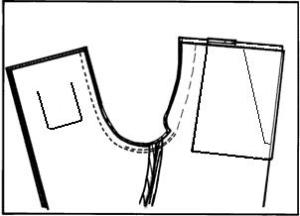 16. Pull one leg RIGHT SIDE OUT and drop down into other leg. Align and match up inner leg seam and CB seam. Baste/pin crotch seam. Sew seam from bottom of fly to top edge of back section (in a U-shape). Turn garment RIGHT SIDE OUT and set aside.
16. Pull one leg RIGHT SIDE OUT and drop down into other leg. Align and match up inner leg seam and CB seam. Baste/pin crotch seam. Sew seam from bottom of fly to top edge of back section (in a U-shape). Turn garment RIGHT SIDE OUT and set aside.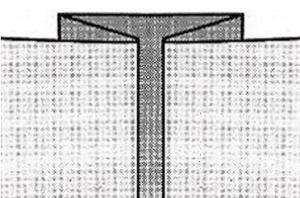 18. Pin raw edge of waistband FACE UP to inside edge of garment’s waistline, allowing for 2” [50mm] extension on left-hand side of waistband. Ease in waistline onto waistband. Fold a
18. Pin raw edge of waistband FACE UP to inside edge of garment’s waistline, allowing for 2” [50mm] extension on left-hand side of waistband. Ease in waistline onto waistband. Fold a 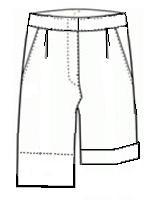 19. With garment FACE UP, sew a J-stitch to secure the fly. Begin with a bar-tack at the bottom of the fly opening and topstitch the J-stitch following the basting thread markings up to the top, stitching through the waistband.
19. With garment FACE UP, sew a J-stitch to secure the fly. Begin with a bar-tack at the bottom of the fly opening and topstitch the J-stitch following the basting thread markings up to the top, stitching through the waistband.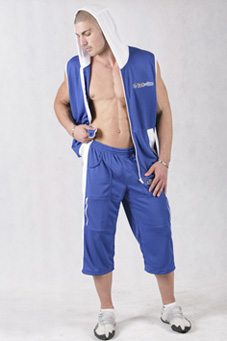 Featured: Dry Max Hooded Vest
Featured: Dry Max Hooded Vest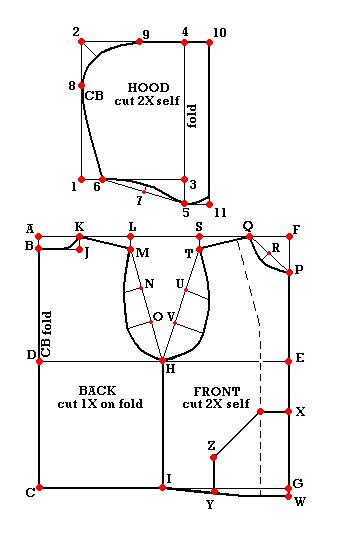
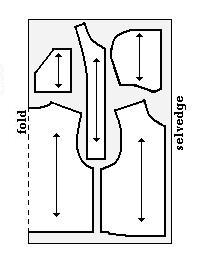 CUTTING
CUTTING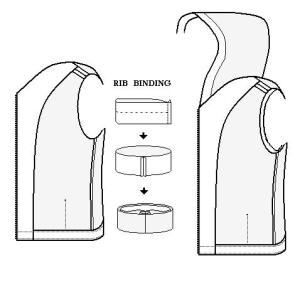 Trim armholes with ribbed binding.
Trim armholes with ribbed binding.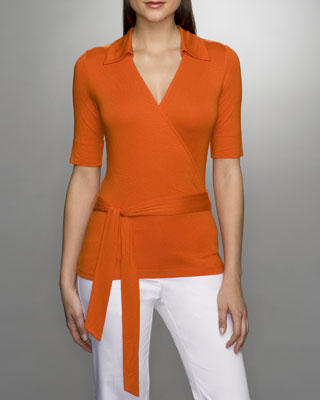 Featured: Wrap Top by NY&Company
Featured: Wrap Top by NY&Company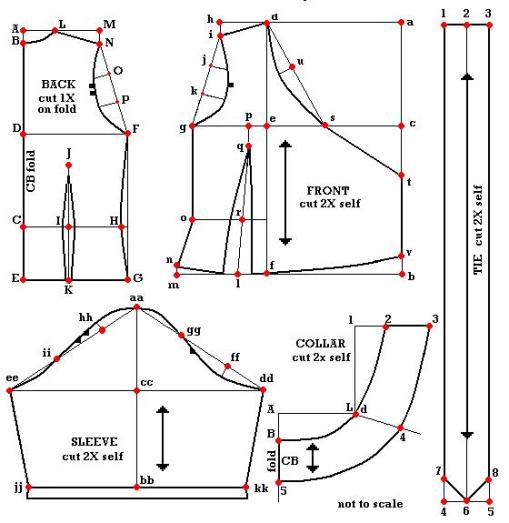 BACK SECTION
BACK SECTION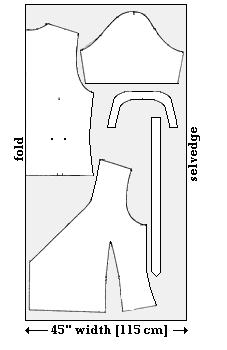 CUTTING
CUTTING 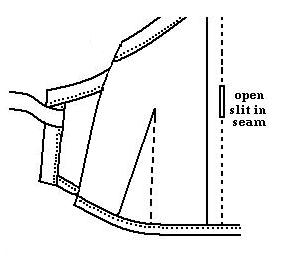 Turn under the vertical front edges of the garment ⅜” [1cm] towards the inside of the garment. Turn under again by ⅜” [1cm]. As you topstitch the turn down, attach a tie to each front just below the neckline edge by encasing the open end of the tie in the seaming. Once the topstitch is complete, fold the tie over the garment edge and secure in place with a second row of topstitching.
Turn under the vertical front edges of the garment ⅜” [1cm] towards the inside of the garment. Turn under again by ⅜” [1cm]. As you topstitch the turn down, attach a tie to each front just below the neckline edge by encasing the open end of the tie in the seaming. Once the topstitch is complete, fold the tie over the garment edge and secure in place with a second row of topstitching.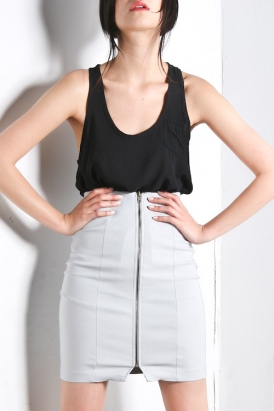 Featured: Purple Label Zip Skirt
Featured: Purple Label Zip Skirt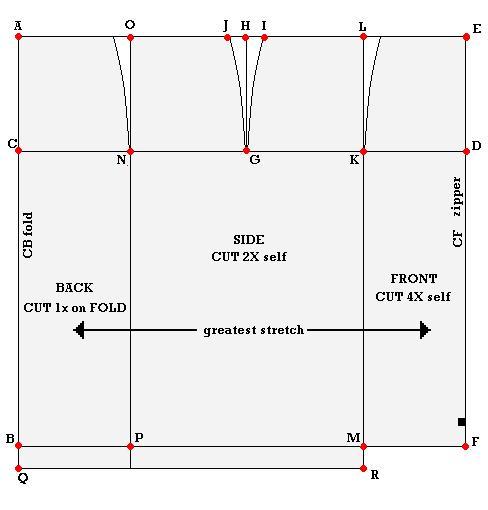
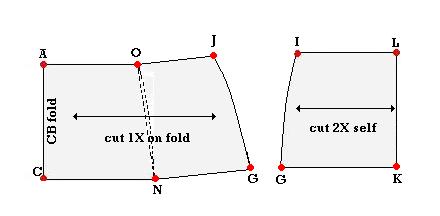 To draft the skirt facing, trace off A-O-J-G-N-C and I-L-K-G on additional paper down to the hipline.
To draft the skirt facing, trace off A-O-J-G-N-C and I-L-K-G on additional paper down to the hipline.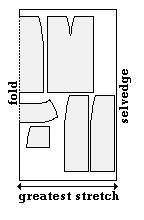
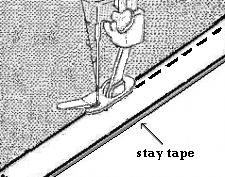 Cut the stay tape equal to the body measurement where you like to wear your skirts. (approximately 2″ [50mm] below waistline)
Cut the stay tape equal to the body measurement where you like to wear your skirts. (approximately 2″ [50mm] below waistline)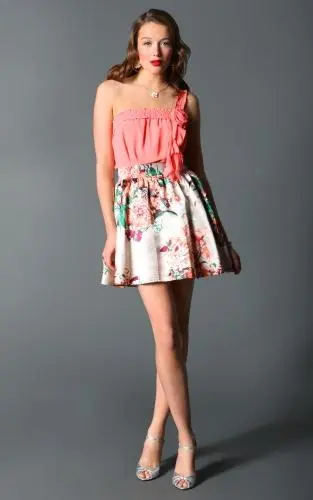 Featured: Wrap Skirt by Charlotte Russe
Featured: Wrap Skirt by Charlotte Russe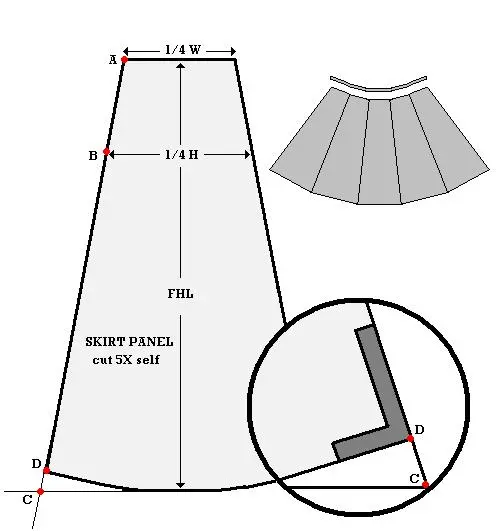 Draw a T shape with the vertical base equal to the Finished Hem Length (FHL) and the centered horizontal top equal to ¼ of the Waist measurement (W).
Draw a T shape with the vertical base equal to the Finished Hem Length (FHL) and the centered horizontal top equal to ¼ of the Waist measurement (W).
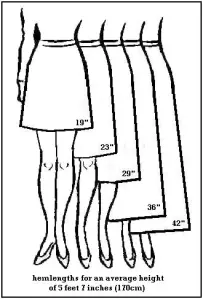 Cut 5 panels for each fabric. **
Cut 5 panels for each fabric. **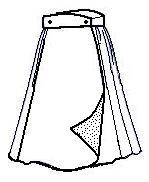 Turn all seam allowances to inside of waistband and align folded edge to machine-stitching on skirt waistline. Edge-stitch around perimeter of the waistband.
Turn all seam allowances to inside of waistband and align folded edge to machine-stitching on skirt waistline. Edge-stitch around perimeter of the waistband.